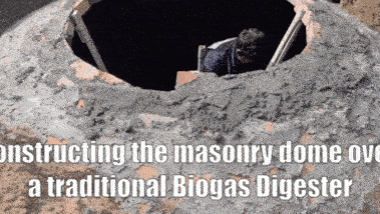Sewage sludge is notoriously slow to digest. Ultrasonic disintegration provides an environmentally responsible way to improve biogas output.

Unsurprisingly wastewater treatment works biogas plant operators have been first to adopt ultrasonic disintegration. As the technology becomes further developed there is no reason why the AD industry won't also adopt it's use for other similarly slow yielding feedstocks such as “on-farm dairy manure digestors”.
There is not a great deal of information published online about ultrasonic disintegrators, so in the following sections we have compiled a guide, based upon statements found online. The original sources are also provided so that you can follow up on each excerpt as necessary.
To get started you may want to watch our video below. It's less than 2 minutes long and provides a definition of ultrasonic disintegration:
How Ultrasonic Disintegration of Biomass Works Physically
Biological cell lysis is known to be the rate-limiting step of anaerobic biosolids degradation. Shear forces generated by low-frequency ultrasound can be used to disintegrate bacterial cells in sewage sludge.
Thus, the quantity of dissolved organic substrate is increased. Consequently, the degradation rate and the biodegradability of organic biosolids mass are improved. via sciencedirect.com
And, from Another Source:
Thanks to high-power ultrasound technology, it is possible to affect the disintegration of the biomass as a result of cavitation, the forces of which are capable of destroying every robust surface.
High-intensity ultrasound is used to tear apart water molecules during the rarefaction phase, which results in the formation of microscopically small voids in the liquid.
These voids become bubbles filled with water vapour or gas. They grow in extension phases and shrink in compression phases until they implode. This event is called cavitation, a process under extreme (adiabatic) conditions. via via ultrawaves.de
How Large are the Pressures Created in Ultrasonic Degraders?
On a micro-scale, pressures of 500 bar and a temperature of 5,000°C are produced. Particularly large cavitation bubbles are produced within the frequency range from 20 to 100 kHz; when these bubbles collapse they cause extreme mechanical shear forces. These forces produced by ultrasound are capable of destroying even the most robust surfaces. via ultrawaves.de
The shear forces can disintegrate fibrous, cellulosic material into fine particles and break the walls of the cell structure.
How Ultrasonic Disintegration of Biomass Works Bio-Chemically to Accelerate the Anaerobic Digestion Process
This releases more of the intra-cellular material, such as starch or sugar into the liquid. In addition to that, the cell wall material is being broken into small debris.
This effect can be used for fermentation, digestion and other conversion processes of organic matter. After milling and grinding, ultrasonication makes more of the intra-cellular material e.g. starch as well as the cell wall debris available to the enzymes that convert starch into sugars.
It does also increase the surface area exposed to the enzymes during liquefaction or saccharification.
This does typically increase the speed and yield of yeast fermentation and other conversion processes, e.g. to boost the ethanol production from biomass. via hielscher.com
Alternatives to Ultrasonic Disintegration Most Often Used in Sewage Sludge Digestors
There are alternative types of disintegration techniques. These are:
- mechanical (ultrasonic disintegration, homogenizations),
- thermal (hydrolysis—low and high temperature),
- chemical (hydrolysis with oxygen, ozone, sodium hydroxide) and
- biological (with the application of enzymes).
What Works Best to Improve Biogas Output?
Currently, mechanical methods are the most effective and commonly used, especially ultrasonic disintegration, which is based on the cavitation phenomenon.
Ultrasonic disintegration shortens the hydrolytic phase, i.e., the rate-limiting step of anaerobic digestion (AD), and increases the efficiency of the process.
Moreover, ultrasonic disintegration (UD) increases the solubility of the organic compounds (by disrupting the sludge floc and cells), leading to a release of intracellular materials available for living organisms, which can be used as a substrate in the subsequent steps of anaerobic digestion.
It must be emphasized, that ultrasonic disintegration is one of the most secure and environmentally friendly methods of anaerobic sludge digestion intensification.
Advantages of Sludge Ultrasonic Disintegration (UD)
…The advantages of sludge UD are:
- lack of byproducts
- [No need to] use of additional reagents and the possibility to intervene during the process conducting
The 2 Types of Ultrasonic Disintegration Effects
We can distinguish two types of ultrasonic disintegration effects: direct and technological:
- The direct effects are observed after ultrasonic pre-treatment [e.g. reduced viscosity], whereas the
- technological during further sludge treatment, i.e., anaerobic digestion.
The obtained effects are described by appropriate indicators of disintegration:
The direct effects are monitored based on the:
- physicochemical changes of sludge characteristics (parameters) before
- and after pre-treatment.
Test Parameters to Use When Monitoring Ultrasonic Disintegration Effects
In the case of anaerobic digestion the expected effects [to watch out for] are:
- increase in biogas production, total solids (TS) and
- volatile solids (VS) reduction, as well as
- dewatering ability improvement. via pdfs.semanticscholar.org
Articles and Case Studies on the Commercial Potential of Ultrasonic Sewage Sludge Disintegration
Disintegration – i.e. the crushing of sewage sludge, has great potential for making sewage plants more economical and efficient. International studies show that 50% of all biogas production plants work sub … via (GSD)
Ultrasonic Sludge Disintegration A ‘Bubbly’ Solution For Anaerobic Digestion Or BNR
 One of the ongoing challenges in wastewater treatment facilities is the handling of biosolids. It has been found that the total biosolids generation continues to increase each year. In fact, the processing, treatment, and disposal of sludge for beneficial use accounts for approximately 40 to 60% of the total wastewater treatment plant (WWTP) expenditures. These expenditures can certainly add up over the life of a wastewater treatment plant; therefore, it is important when designing a wastewater treatment plant to have an efficient and effectively operated solids handling system. Ultrasonic sludge disintegration, by way of ultrasound, is a proven method to help mitigate this very issue.
One of the ongoing challenges in wastewater treatment facilities is the handling of biosolids. It has been found that the total biosolids generation continues to increase each year. In fact, the processing, treatment, and disposal of sludge for beneficial use accounts for approximately 40 to 60% of the total wastewater treatment plant (WWTP) expenditures. These expenditures can certainly add up over the life of a wastewater treatment plant; therefore, it is important when designing a wastewater treatment plant to have an efficient and effectively operated solids handling system. Ultrasonic sludge disintegration, by way of ultrasound, is a proven method to help mitigate this very issue.
via A ‘Bubbly' Solution For Anaerobic Digestion Or BNR
Energy and Resources From Wastewater – The $45 Billion Value of Sludge in the Sewers
While it's long been simply an expensive nuisance to be disposed of, sewage sludge from wastewater can actually be an untapped source of energy, phosphorus, and other products. As a result, utilities and water treatment facilities have begun to explore technologies designed to help extract the value from wastewater sludge. As these technologies mature, the market opportunity for resource recovery will grow from $25 billion today to $45 billion in 2020, according to a new Lux Research report titled “Technologies Turn Waste into Profit.”
Treatment and handling of sludge can represent between 20% and 50% of a wastewater treatment facility's costs, which has fueled interest in technologies that extract energy, minerals or other materials from sludge to either help offset treatment costs or even turn a profit. Technologies focused on recovering energy from sludge show the most promising value proposition, according to the report, and are expected to capture 64% of the overall market in 2020.
- Improving the production of biogas from sludge offers the strongest value proposition. Several technologies — including ultrasonic cavitation, mechanical disintegration and thermal hydrolysis — aim to improve anaerobic digestion, a well-established method for extracting biogas from sludge. These pre-treatment technologies scored highly on technical criteria, enhancing biogas production by 40% to 50%. via Energy and Resources
Ultrasound improves sewage sludge treatment
Ultrasound treatment, which involves the introduction of high-intensity sound waves into a sludge medium, is one of several technologies that promote hydrolysis during sludge treatment. …
The technology has been used successfully at full-scale in mainland Europe for several years with 14 plants in operation, but recent data from two full-scale treatment plants in Germany documented impressive results.
Case Study – Sewage treatment plant in Süd, Germany
Ultrasound treatment of secondary sewage sludge improved volatile solids destruction in anaerobic digesters by an average of 50%, which subsequently increased biogas production by 45% at a sewage treatment plant in Süd, Germany. The feed stream of the anaerobic digester at this site is now 100% secondary sludge. In addition, dewatering performance improved by five percentage points whilst using 11% less polymer.
Case Study – Wallerfangen, Germany
Volatile solids destruction increased from 50% to 62% at a sludge treatment plant using ultrasound technology at Wallerfangen, Germany. Here, the feed stream is a mixture of primary and secondary sludge at a ratio of 35:65. In addition, biogas production increased by an average of approximately 25%. In the dewatering plant, cake solids content increased by up to seven percentage points (an improvement of >40%) from a belt press despite using 33% less polymer. Dewatering performance improved from 17% to 24% dry solids. Together, improved dewatering and volatile solids destruction resulted in 30% less sludge cake leaving the works. via Ultrasound improves sludge
Conclusion
A common method for the biodegradation of excess sludge is biological treatment by anaerobic digestion. Anaerobic digestion is commonly used for stabilization and solid reduction of treatment plant sludges.
Anaerobic digestion is a slow process because of the hydrolysis stage which is the rate-limiting step of the sludge degradation. That disadvantage is a major factor for the treatment of Sewage Works Sludge.
Ultrasound [provides a solution because it] has a positive effect on sludge solubilisation, sludge volume, biogas production, flock size reduction and cells lysis.
Ultrasonic pre-treatment enhances the subsequent anaerobic digestion. This results in a better degradation of volatile solids and an increased production of biogas.
The use of low power ultrasound in bioreactors may present a significant improvement in cost reduction.
Therefore, ultrasonic pre-treatment enhances the subsequent anaerobic digestion resulting in better sludge digestion and efficient recovery of valuables. via www.cleantechloops.com



Thank you for the interesting write up. Looks like this is one of those areas where a technology transfer from one industry to another can occur. Ultrasonics is a good way to do cleaning of many things but not this before.